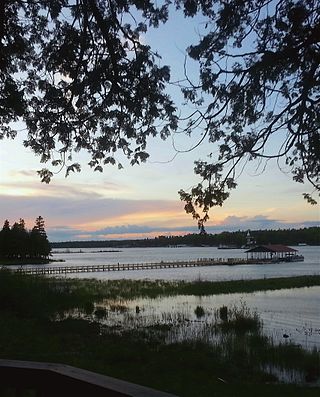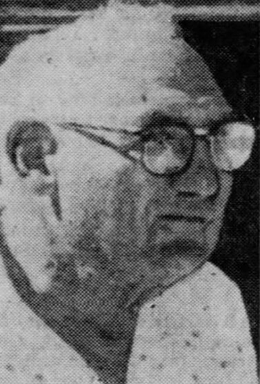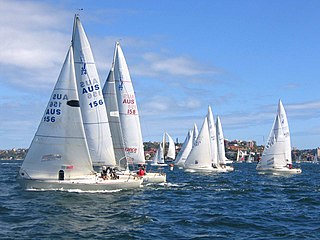
Mackinac Island is an island and resort area, covering 4.35 square miles (11.3 km2) in land area, in the U.S. state of Michigan. The name of the island in Odawa is Michilimackinac and "Mitchimakinak" in Ojibwemowin meaning "Great Turtle". It is located in Lake Huron, at the eastern end of the Straits of Mackinac, between the state's Upper and Lower Peninsulas. The island was long home to an Odawa settlement and previous indigenous cultures before European colonization began in the 17th century. It was a strategic center of the fur trade around the Great Lakes. Based on a former trading post, Fort Mackinac was constructed on the island by the British during the American Revolutionary War. It was the site of two battles during the War of 1812 before the northern border was settled and the US gained this island in its territory.

Yacht racing is a sailing sport involving sailing yachts and larger sailboats, as distinguished from dinghy racing, which involves open boats. It is composed of multiple yachts, in direct competition, racing around a course marked by buoys or other fixed navigational devices or racing longer distances across open water from point-to-point. It can involve a series of races with buoy racing or multiple legs when point-to-point racing.
A match race is a race between two competitors, going head-to-head.

The Rolex Sydney Hobart Yacht Race is an annual event hosted by the Cruising Yacht Club of Australia, starting in Sydney, New South Wales, on Boxing Day and finishing in Hobart, Tasmania. The race distance is approximately 630 nautical miles (1,170 km). The race is run in conjunction with the Royal Yacht Club of Tasmania, and is widely considered to be one of the most difficult yacht races in the world.

The Fastnet Race is a biennial offshore yacht race organised by the Royal Ocean Racing Club (RORC) of the United Kingdom with the assistance of the Royal Yacht Squadron in Cowes and the City of Cherbourg in France.

Les Cheneaux Islands are an archipelago of 36 small islands, some inhabited, along 12 miles of Lake Huron shoreline on the southeastern tip of the Upper Peninsula of Michigan in the United States. The name is French for "the Channels", noting the many channels between the islands in the group. They are about 30 miles northeast of Mackinac Island and about 35 miles south of Sault Ste. Marie. The islands are a popular resort and boating and kayaking area. The nearby communities of Hessel and Cedarville on the mainland offer marinas, camping, lodging, restaurants, and shopping. The Les Cheneaux Islands Antique Boat Show & Festival of the Arts has been held on the second Saturday of each August since 1976 in Hessel. It is the world's largest antique wooden boat show.

The Chicago Yacht Club Race to Mackinac is a 333-mile annual yacht race starting in Lake Michigan off Chicago, Illinois, and ending in Lake Huron off Mackinac Island, Michigan. It is hosted and managed by the Chicago Yacht Club. The "Mac" was first run in 1898 and is the oldest annual freshwater distance race in the world. The race hosts several hundred competitors each year and over 3,000 sailors.

The Marblehead to Halifax Ocean Race (MHOR) is a biennial sailing race which celebrated its 100th anniversary in 2005. It runs between Marblehead, Massachusetts and Halifax, Nova Scotia. It is believed to be the longest running offshore ocean race in the world and is considered one of the pre-eminent ocean races of the North Atlantic.
Performance Handicap Racing Fleet (PHRF) is a handicapping system used for yacht racing in North America. It allows dissimilar classes of sailboats to be raced against each other. The aim is to cancel out the inherent advantages and disadvantages of each class of boats, so that results reflect crew skill rather than equipment superiority.

Clare Stephen Jacobs was an accomplished businessman, yacht racer, and American track athlete who competed mainly in the pole vault and won an Olympic Bronze medal in the sport in 1908. He was born in Madison, Dakota Territory.

Bayview Yacht Club is private, sailing-focused yacht club located in Detroit, Michigan. Bayview is famous for hosting the Port Huron to Mackinac Boat Race as well as a number of other regional and local regattas.
The Launceston to Hobart yacht race is a 285 nautical mile race, commencing at Beauty Point on the Tamar River, with competitors sailing out of the Tamar River, east along the northern coast of Tasmania, through Banks Strait and south down Tasmania's East Coast, through Mercury Passage between mainland Tasmania and Maria Island, across Storm Bay, to a finish line in the Derwent River. The race departs on 27 December each year. The race is known as the L2H race despite the race commencing at Beauty Point, some 45 kilometers north of Launceston.
The Round Island Channel is a navigable Lake Huron waterway located between Mackinac Island and Round Island in the Straits of Mackinac. It forms a key link in the lake freighter route between Lake Superior and Lake Michigan, on which millions of tons of taconite iron ore are shipped annually. The channel also provides access to the harbor of Mackinac Island, Michigan, and is used by commercial ferryboats delivering passengers to the small island city.

The Brisbane to Gladstone yacht race is held annually, starting on Good Friday. The premier blue water classic begins from Shorncliffe in Moreton Bay, Queensland, Australia, and finishes in Gladstone Harbour. Yachts compete for the Courier Mail Cup, one of the oldest perpetual trophies in Australia that has been competed for on a continual basis.
The Parmelia Race, Plymouth to Perth, 1979 was a feature event of the Western Australian 150th Anniversary Celebrations, 1979. Competitors were invited to recreate the 1829 voyage of the merchant barque Parmelia bringing the first British settlers to the Swan River Colony. The race was organised by the Royal Perth Yacht Club of Western Australia and sponsored by The Parmelia Hilton International, Perth

The sport of sailing involves a variety of competitive sailing formats that are sanctioned through various sailing federations and yacht clubs. Racing disciplines include matches within a fleet of sailing craft, between a pair thereof or among teams. Additionally, there are specialized competitions that include setting speed records. Racing formats include both closed courses and point-to-point contests; they may be in sheltered waters, coast-wise or on the open ocean. Most competitions are held within defined classes or ratings that either entail one type of sailing craft to ensure a contest primarily of skill or rating the sailing craft to create classifications or handicaps.

Sydney Flying Squadron Yacht club was founded in 1891 by Mark Foy in the birthplace of the famous Sydney Harbour sailing skiff classes. It was founded to allow people to enjoy skiff sailing regardless of financial background. The Sydney Flying Squadron, affectionately called The Squaddy by its members and locals, is Australia's oldest open boat sailing club on the shores of Sydney Harbour.
The Super Mac is a non-periodic 568 mile sail boat race from Chicago, IL to Port Huron, MI, or vice versa. Recent editions have been jointly sponsored by the Chicago Yacht Club, Bayview Yacht Club and Port Huron Yacht Club. The 2015 race was promoted as "The Longest Fresh Water Race on Earth," a debatable claim.
Handicap forms for sailing vessels in sailing races have varied throughout history, and they also vary by country, and by sailing organisation. Sailing handicap standards exist internationally, nationally, and within individual sailing clubs.
The 1930 America's Cup was the 14th challenge for the Cup. It took place in Newport and consisted of a series of races between the defender Enterprise, entered by a syndicate of New York Yacht Club members headed by Winthrop Aldrich, and Shamrock V, the fifth in Sir Thomas Lipton's line of Cup challengers.











